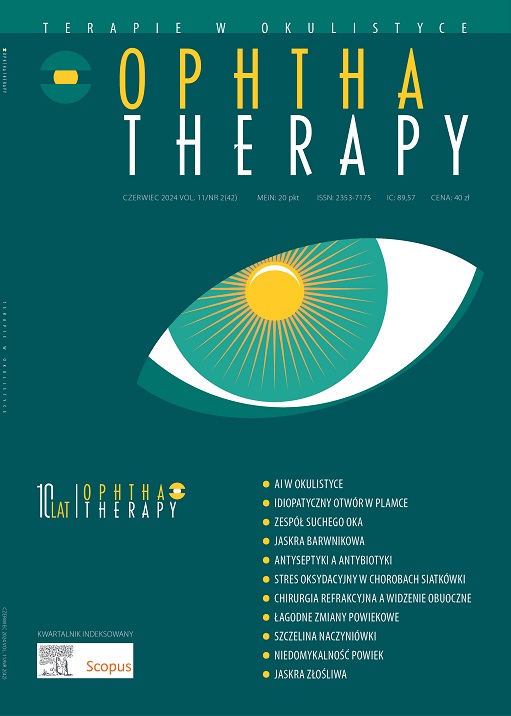Latanoprost drops without added detergent in the treatment of glaucoma Commentary
Main Article Content
Abstract
Chronic nature of both the disease and its therapy forces ophthalmologists to choose the treatment with the lowest potential for adverse reactions, which may be caused by the active substance, excipient or preservative. Detergents used in ophthalmic drops include a derivative of macrogolglycerol hydroxystearate-40 (MGHS-40), which in in vitro tests showed pro-inflammatory and cytotoxic properties towards corneal epithelial cells, and this effect increased with increasing concentration and time. The analyzed observational study showed that latanoprost without MGHS-40 effectively reduces intraocular pressure, and the factors encouraging ophthalmologists to choose this preparation were good local tolerance and a simple composition (without detergents, preservatives and antioxidants), improving compliance. In the observational study, 82.3% received latanoprost without MGHS-40, and almost 60% started antiglaucoma treatment with this preparation.
Downloads
Article Details
Copyright: © Medical Education sp. z o.o. License allowing third parties to copy and redistribute the material in any medium or format and to remix, transform, and build upon the material, provided the original work is properly cited and states its license.
Address reprint requests to: Medical Education, Marcin Kuźma (marcin.kuzma@mededu.pl)
References
2. Hollo G, Katsanos A, Boboridis KG et al. Preservative-free prostaglandin analogs and prostaglandin/timolol fixed combinations in the treatment of glaucoma: efficacy, safety and potential advantages. Drugs. 2018; 78: 39-64.
3. Zhang X, Vadoothker S, Munir WM et al. Ocular surface disease and glaucoma medications: a clinical approach. Eye Contact Lens. 2019; 45(1): 11-8.
4. Kluk A, Sznitowska M. Substancje pomocnicze w lekach do oczu. Technologia postaci leku. 2010; 66(8): 567-72.
5. Smedowski A, Paterno JJ, Toropainen E. Excipients of preservative-free latanoprost induced inflammatory response and cytotoxicity in immortalized human HCE-2 corneal epithelial cells. J Biochem Pharmacol Res. 2014; 2(4): 175-84.
6. Janicki S, Fiebig A, Sznitowska M. Farmacja Stosowana. Podręcznik dla studentów farmacji. Wydanie IV uzupełnione. Warszawa 2013.
7. Zdzieszyńska M. Clinical and therapeutic profile of patients with glaucoma treated with latanoprost without macroglycerol-40 hydroxystearate (MGHS-40) – observational study. Ophthatherapy. 2024; 11(2).
8. Bacharach J, Ahmed IIK, Sharpe ED et al. Preservative-Free versus Benzalkonium Chloride–Preserved Latanoprost Ophthalmic Solution in Patients with Primary Open-Angle Glaucoma or Ocular Hypertension: A Phase 3 US Clinical Trial. Clin Ophthalmol. 2023; 17: 2575-88. http://doi.org/10.2147/OPTH.S414015.
9. Davuluru SS, Jess AT, Kim JSB et al. Identifying, understanding, and addressing disparities in glaucoma care in the United States. Transl Vis Sci Technol. 2023; 12(10): 18. http://doi.org/10.1167/tvst.12.10.18.
10. Harasymowycz P, Hutnik C, Rouland JF et al. Preserved Versus Preservative-Free Latanoprost for the Treatment of Glaucoma and Ocular Hypertension: A Post Hoc Pooled Analysis. Adv Ther. 2021; 38(6): 3019-31. http://doi.org/10.1007/s12325-021-01731-9.
11. Lee JW, Ahn HS, Chang J et al. Comparison of Netarsudil/Latanoprost Therapy with Latanoprost Monotherapy for Lowering Intraocular Pressure: A Systematic Review and Meta-analysis. Korean J Ophthalmol. 2022; 36(5): 423-34. http://doi.org/10.3341/kjo.2022.0061.
12. Alm A. Latanoprost in the treatment of glaucoma. Clin Ophthalmol. 2014; 8: 1967-85. http://doi.org/10.2147/OPTH.S59162.

